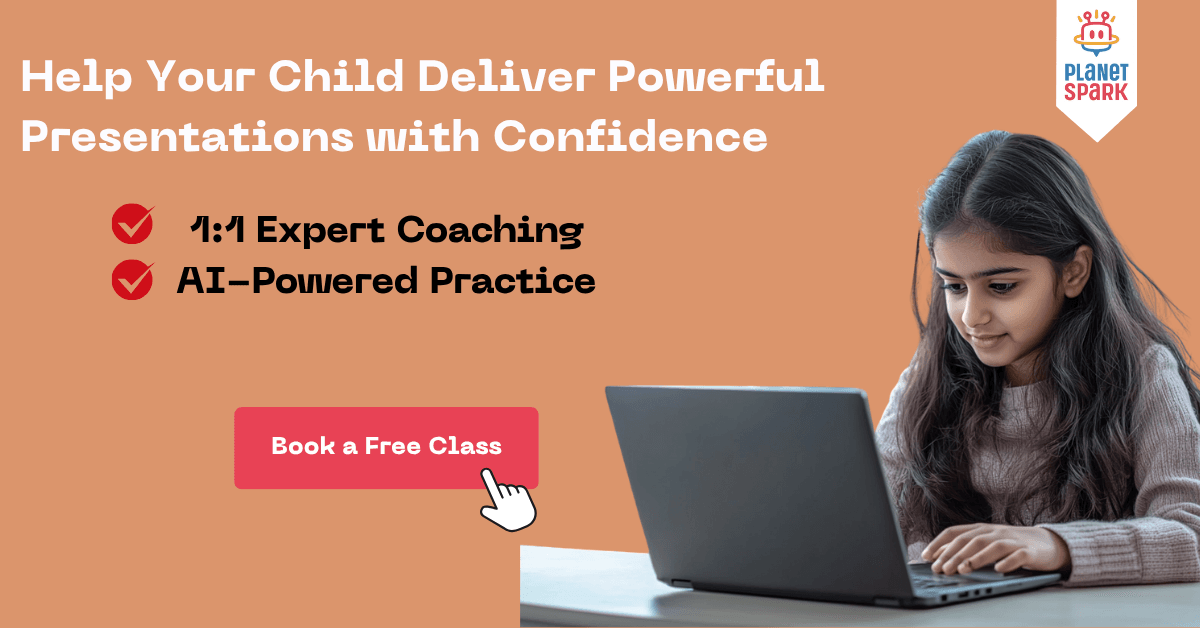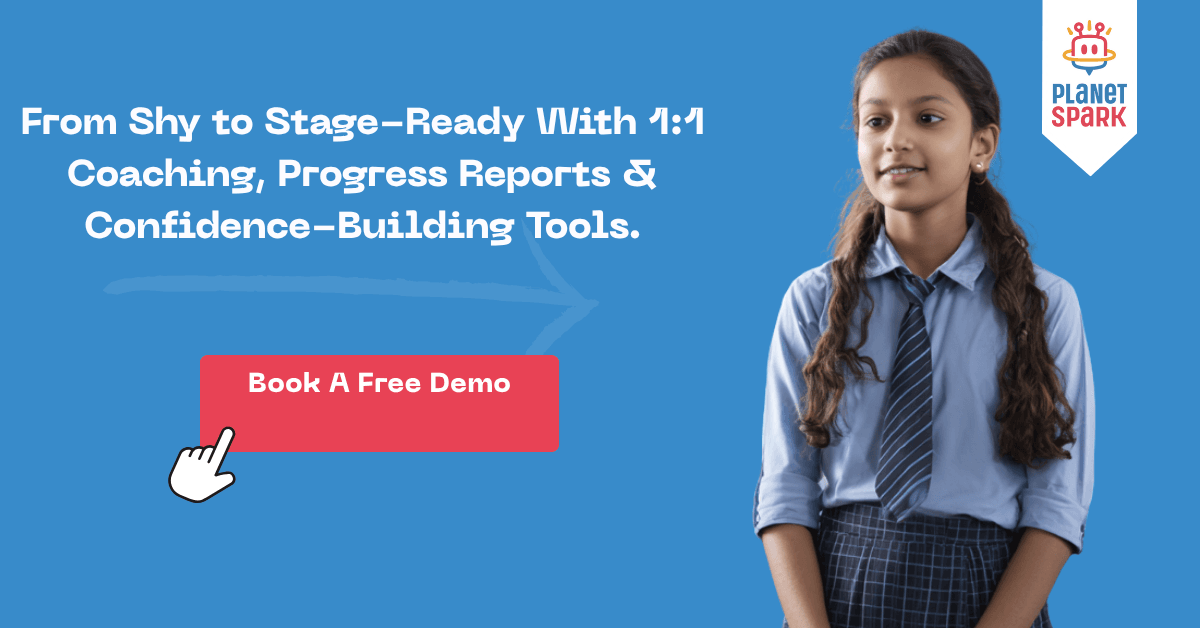How to Start a Presentation: Best Tips for Students and Kids

Table of Contents
- Why the Beginning of a Presentation Matters
- How to Start a Presentation Speech
- How to Start a Seminar Presentation
- 10 Pro Tips to Start a Presentation
- Sample Opening Lines for Students
- How to Overcome Nervousness Before a Presentation
- How PlanetSpark Helps Your Child Start Presentations with Co
- Ready to Help Your Child Own the Stage?
- FAQs on How to Start a Presentation
Giving a presentation can be intimidating, especially for school-age children who are still developing confidence. The way a child begins their presentation often sets the stage for the entire talk. A strong start not only captures the audience’s attention but also builds the speaker’s own confidence.
At PlanetSpark, we help children master these crucial first moments with personalized training, real-time feedback, and modern communication tools. In this blog, you’ll discover everything a child needs to know about starting a presentation effectively, along with examples, tips, and structured practice ideas.
Why the Beginning of a Presentation Matters
The beginning of a presentation acts as the first impression. It helps your audience decide whether to listen intently or tune out. For school students, teachers and judges often base much of their feedback on the opening delivery, posture, and clarity. A confident, well-structured opening shows preparation and leadership.
Take this example:
“Did you know that by 2050, there will be more plastic than fish in the ocean?”
Starting with a powerful fact instantly makes your audience curious and ready to engage.

How to Start a Presentation Speech
The best way to begin a presentation is with a hook. This can be a question, story, quote, or surprising fact. After that, introduce yourself and clearly state your topic. Keep the tone natural and maintain eye contact if presenting live.
Example for Kids:
“Good morning everyone. I’m Ananya, and today I’ll take you on a journey to the center of our solar system. But first, do you know what planet is the hottest, not the closest to the sun?”
This approach draws listeners in and makes the speaker feel in control right from the beginning.
How to Start a Seminar Presentation
In more formal or academic settings like school seminars or competitions, the structure needs to be a bit more polished. Here’s a simple format students can follow:
Start with a formal greeting
Introduce yourself and your topic
Use a hook relevant to the subject
Establish the purpose or importance of your topic
Example:
“Good morning respected judges and fellow classmates. I am Aarav Mehta, and I’ll be presenting on ‘The Role of AI in Classrooms.’ As Stephen Hawking once said, ‘AI could be the best or worst thing to happen to humanity.’ Let's explore how it impacts education.”
10 Pro Tips to Start a Presentation
Whether your child is preparing for a class speech or a competition, these tips will help them start confidently and effectively.
1. Memorize Your First Few Lines
The opening lines should be so familiar that they come out naturally. It gives your child a strong, calm start.
2. Practice with a Mirror or a Trusted Listener
Kids become more aware of their gestures and expressions by seeing themselves or receiving feedback from someone supportive.
3. Use a Strategic Pause Before Speaking
This small pause builds anticipation and helps the speaker settle into their space.
4. Smile and Make Eye Contact
A warm greeting combined with a smile instantly makes the speaker more relatable and helps reduce nerves.
5. Keep the Opening Short and Powerful
The opening should be under 20 seconds, packed with a hook and clarity about the topic.
6. Use Open Body Language
Standing tall, uncrossed arms, and purposeful hand gestures communicate confidence.
7. Don’t Undermine Yourself
Never begin with “I’m not good at this” or “Sorry if this is boring.” Start with energy and belief in your message.
8. Ask a Rhetorical or Engaging Question
This invites the audience to think. Example: “Have you ever dreamed of flying without wings?”
9. Tie Your Opener to Your Topic
Make sure the hook smoothly connects to what you are presenting. A fun story should always lead into the subject.
10. Record and Time the Opening
Practice on camera. Watching the playback helps kids notice pacing, voice clarity, and expressions.
Bonus Tip: Use hand gestures to emphasize points. They not only aid memory but also make the delivery more engaging.
Sample Opening Lines for Students
Here are some creative and adaptable opening lines kids can use across different topics:
“What if your phone could think faster than you?”
“Let’s take a minute to imagine a world with no gravity.”
“I have a confession. I was once afraid of speaking on stage.”
“Today, I want to show you how small actions can create big change.”
These openers work well for academic topics, storytelling sessions, and even class presentations.
How to Overcome Nervousness Before a Presentation
Stage fright is natural. Here’s how your child can manage it effectively:
Rehearse Often: Familiarity reduces fear
Use Breathing Exercises: Deep breaths relax the body
Visualize Applause: Imagine a successful delivery
Start Small: Practice with parents or friends before the big day
Use Positive Affirmations: Say “I’m ready, and I will do well”
Confidence doesn’t happen overnight. It’s built through practice and guidance.

How PlanetSpark Helps Your Child Start Presentations with Confidence
PlanetSpark’s Public Speaking Program is designed to help kids go from hesitant to stage-confident using a scientifically structured approach and expert coaching.
1:1 Public Speaking Coaching by Communication Experts
Every student is paired with a certified communication coach trained in child psychology. This ensures real-time correction, individual feedback, and personal growth.
Step-by-Step Skill Building
Children master the following skills gradually:
Body language and facial expressions
Voice modulation and vocal variation
Structured speech writing and logical flow
Storytelling and persuasive speaking techniques
Debating strategies including rebuttals and respectful disagreement
TED-Style Training Modules
Kids learn to create presentations using the Hook, Message, Story, and Call-to-Action format inspired by TEDx speakers.
Real-Time Practice with Global Peers
Children engage in debates, panel discussions, and storytelling with peers from 13+ countries, gaining exposure and real-time feedback.
AI Video Feedback and Practice Tools
Through SparkX, students receive detailed AI feedback on grammar, pacing, and modulation. Videos are reviewed by both the coach and child for progress tracking.
Spark Diary for Writing Practice
Kids journal speeches, reflections, and creative content daily, building structure and fluency in speech and writing.
Gamified Learning for Better Retention
Quizzes like Grammar Guru Challenge and Spell Knockout make learning exciting, consistent, and reward-based.
Transparent Progress Tracking and Parent Reports
Detailed performance reports and regular PTMs ensure parents are always informed and involved in the learning journey.
Clubs and Communities for Real-World Application
From Debate Club to Podcasting Circle, kids get to apply their learning and perform publicly in a safe and encouraging environment.
Ready to Help Your Child Own the Stage?
Learning how to start a presentation is just the beginning. PlanetSpark helps children build full communication fluency from writing their thoughts to delivering them powerfully on stage.
Explore our Public Speaking Program and book a free demo class today. Let’s turn your child into a confident speaker who shines from the very first line.
FAQs on How to Start a Presentation
Q1. What is the best way to start a presentation for students?
The best way to start a presentation is with a hook such as a question, story, quote, or fact that grabs attention. Follow it with your introduction and topic overview.
Q2. How do I start a school presentation confidently?
Start with a smile, take a deep breath, and give a clear greeting. Memorize your first few lines and practice them until they feel natural. Confidence comes from preparation and repetition.
Q3. How to start a presentation speech in English for kids?
Use simple, friendly language. Begin with “Good morning everyone, my name is…” and follow with an interesting question or story related to your topic.
Q4. How to start a presentation for a seminar?
In a seminar, begin formally with a greeting, your name, and your topic. Then use a relevant quote or surprising fact to engage the audience right away.
Q5. What are some effective opening lines for a presentation?
Examples include:
“Have you ever wondered…”
“Let me share a quick story with you…”
“Did you know that…”
These types of openers grab attention and invite curiosity.
Q6. Why is the introduction of a presentation important?
The introduction sets the tone for everything that follows. It captures your audience’s attention and boosts your confidence as a speaker.
Q7. How can PlanetSpark help my child start presentations confidently?
PlanetSpark provides 1:1 public speaking coaching, TED-style speech training, AI-enabled feedback tools, and structured practice that help children open their presentations with clarity, structure, and impact.
Personalized Communication Report
Record a video to get a AI generated personalized communication report for your child

Hi There, want to try these
tips for your child with
LIVE with our expert coach?
Let's check your child's
English fluency
